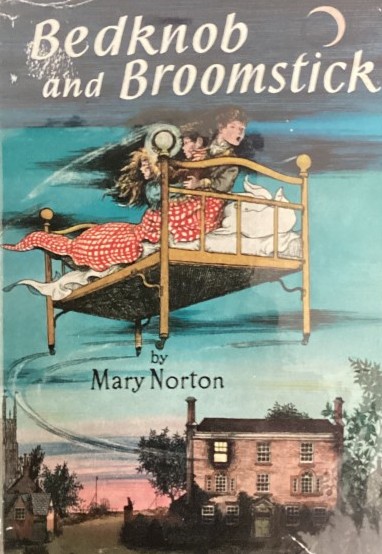Inspiring Young Readers
 posted on 14 Jun 2023
posted on 14 Jun 2023
Bedknob and Broomstick by Mary Norton
Some months ago I decided that I needed to catch-up on the ‘classic’ children’s books I never read when I was young enough to be the target audience. It is, of course, quite a different experience reading these books in my advancing years but I’ve been surprised at how easy it is to surrender to the magic in many of these stories – and it’s a real tribute to the skill of the authors who are able to produce timeless – ageless – works of art.
My latest excursion into the world of the children’s classic is Mary Norton’s Bedknob and Broomstick issued in 1957 and illustrated by Erik Blegvad. This is the text that formed the basis of the Disney film adaptation that came along later and it was also this that added the plural ‘s’ to bedknob and broomstick. But this 1957 edition is, in fact, a bringing together of two earlier books, The Magic Bed-knob (1944) and Bonfires and Broomsticks (1947) which the publisher and author decided needed a revamp in the light of the success of Norton’s other famous creation, The Borrowers (1952).
Three children – Carey, Charles and Paul - are sent off to spend the summer in the Bedfordshire countryside with their aunt and are not expecting much by way of excitement. Not until, that is, they discover that a rather prim and proper neighbour, Miss Price, is revealed to be a witch in training. The children witness her rather bumpy attempts at riding a broom and help rescue her from one of her many crashes, promising not to reveal to anyone her real identity. As a reward, Miss Price gives them a gift that will only work if they keep their word – a magic bed-knob that can only be activated by Paul and which will transport the bed and everyone on it to their desired destination.
What follows in the first half of the book is a trip to a local destination where they get farcically involved with the police and then a trip on the flying bed to a ‘paradise’ island which turns out to be populated by cannibals who want to put them in the pot. The new breed of ‘sensitivity readers’ would have a nervous breakdown reading the stereotypical rendition of the island’s ’savages’ as big-lipped, grass-skirted cannibals with bones through the nose but, of course, this was pretty standard fare in children’s books and comics of the 1950s. It isn’t something that would be desirable or possible to write these days but this is very much a book of its time and should be approached in that way – Norton’s depiction of the island natives isn’t done with an ounce of malice but it will seem pretty crude to the modern reader.
A bond is forged between the children and Miss Price, who starts to question whether the use of magic is a good thing or not because she has endangered the children she finds she cares for.
The second half of the book – the Bonfires and Broomsticks section – sees the children return to stay again in Bedfordshire for the summer but this time, almost accidentally, with Miss Price. Carey, Charles and Paul are thrilled at the prospect of renewing their adventures on the magic bed only to discover that Miss Price has now renounced magic forever. But, needless to say, they eventually persuade her to have one last adventure – this time a bit of time travel to the past. They return randomly to 1666 and encounter the rather sad figure of the failing necromancer, Emileus who is bewildered by the real magic the children seem to have access to. He returns with them to the future and tries to adapt but is never really at home and return to his own time only to find he’s blamed for the outbreak of the Great Fire of London and condemned to be burned at the stake for his use of magic.
Can the children and Miss Price use the magic bed to save Emilieus?
Well, I’m not saying because that would be a bit of a spoiler………
Not, in my opinion, anything like as good as The Borrowers, the stories still have a beguiling fantasy fulfilment element to them that includes enough nuance and jeopardy to make them more than just light reading. But they are very much products of their time and will seem dated to children encountering them for the first time – perhaps picking them up because they have seen the Disney film. The idea of a magic bed seems to me to be a bit of a clumsy device and there are several times the notion of an iron bedstead materialising in the local graveyard or garden just pushes credibility to breaking point. But then again, I’m no longer a child and who cares what a jaundiced old man thinks?
Plenty of affordable paperback copies are available for not very much money.
Terry Potter
June 2023